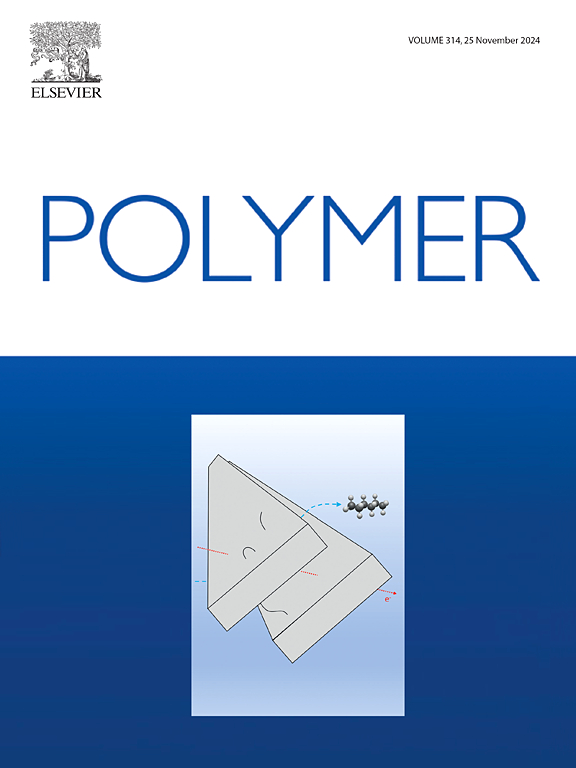Synergistic backbone and side chain engineering on crystalline orientation and charge transport of conjugated polymers in field-effect transistors
IF 4.1
2区 化学
Q2 POLYMER SCIENCE
引用次数: 0
Abstract
Precise control of molecular packing and crystalline orientation in conjugated polymer thin films is crucial for establishing the structure-property relationship in optoelectronic devices. However, achieving this control remains a significant challenge. Herein, we investigate the synergistic effects of backbone and side chain engineering on molecular packing and crystalline orientation in a series of polythiophene derivatives and establish the correlation between their crystalline structures and organic field-effect transistor (OFET) performance. Specifically, the derivatives include poly (3-dodecylthiophene) (C12), poly (2,5-bis(3-dodecylthiophen-2-yl)thiophene) (T-C12), poly (2,5-bis(3-dodecylthiophen-2-yl)thieno [3,2-b]thiophene) (TT-C12), poly (2,6-bis(3-dodecylthiophen-2-yl)dithieno [3,2-b:2′,3′-d]thiophene) (TTT-C12) with different unsubstituted thiophene units in the backbone, along with TTT derivatives bearing varying alkyl side chains (hexyl, decyl, and tetradecyl, denoted as TTT-C6, TTT-C10, and TTT-C14, respectively). Remarkably, TT-C12, with its moderate thiophene units, facilitates the formation of edge-on crystallites with enhanced ordering and orientation. Moreover, TTT-C14, with the longest alkyl side chains, promotes more ordered edge-on crystallites than the other two TTT-C6 and TTT-C10. The charge transport characteristics of these polymers are closely linked to variations in their crystalline structures. This work underscores the effectiveness of molecular engineering in tailoring the crystalline orientation and charge transport. As a model system, the deep insights into the structure-property relationships of polythiophene derivatives can be extended to other conjugated polymers for high-performance optoelectronic devices.


精确控制共轭聚合物薄膜中的分子堆积和晶体取向对于建立光电设备的结构-性能关系至关重要。然而,实现这种控制仍然是一项重大挑战。在此,我们研究了骨架和侧链工程对一系列聚噻吩衍生物的分子堆积和晶体取向的协同效应,并建立了它们的晶体结构与有机场效应晶体管(OFET)性能之间的相关性。具体来说,这些衍生物包括聚(3-十二烷基噻吩)(C12)、聚(2,5-双(3-十二烷基噻吩-2-基)噻吩)(T-C12)、聚(2,5-双(3-十二烷基噻吩-2-基)噻吩并[3,2-b]噻吩)(TT-C12)、聚(2,6-双(3-十二烷基噻吩-2-基)二噻吩并[3,2-b:2',3'-d]噻吩)(TTT-C12),以及带有不同烷基侧链(己基、癸基和十四烷基,分别表示为 TTT-C6、TTT-C10 和 TTT-C14)的 TTT 衍生物。值得注意的是,TTT-C12 具有适度的噻吩单元,有利于形成边缘结晶,并增强有序性和取向性。此外,烷基侧链最长的 TTT-C14 比其他两种 TTT-C6 和 TTT-C10 能促进形成更有序的边缘结晶。这些聚合物的电荷传输特性与其晶体结构的变化密切相关。这项工作强调了分子工程在定制晶体取向和电荷传输方面的有效性。作为一个模型系统,对聚噻吩衍生物结构-性能关系的深刻理解可扩展到用于高性能光电器件的其他共轭聚合物。
本文章由计算机程序翻译,如有差异,请以英文原文为准。
求助全文
约1分钟内获得全文
求助全文
来源期刊

Polymer
化学-高分子科学
CiteScore
7.90
自引率
8.70%
发文量
959
审稿时长
32 days
期刊介绍:
Polymer is an interdisciplinary journal dedicated to publishing innovative and significant advances in Polymer Physics, Chemistry and Technology. We welcome submissions on polymer hybrids, nanocomposites, characterisation and self-assembly. Polymer also publishes work on the technological application of polymers in energy and optoelectronics.
The main scope is covered but not limited to the following core areas:
Polymer Materials
Nanocomposites and hybrid nanomaterials
Polymer blends, films, fibres, networks and porous materials
Physical Characterization
Characterisation, modelling and simulation* of molecular and materials properties in bulk, solution, and thin films
Polymer Engineering
Advanced multiscale processing methods
Polymer Synthesis, Modification and Self-assembly
Including designer polymer architectures, mechanisms and kinetics, and supramolecular polymerization
Technological Applications
Polymers for energy generation and storage
Polymer membranes for separation technology
Polymers for opto- and microelectronics.
 求助内容:
求助内容: 应助结果提醒方式:
应助结果提醒方式:


